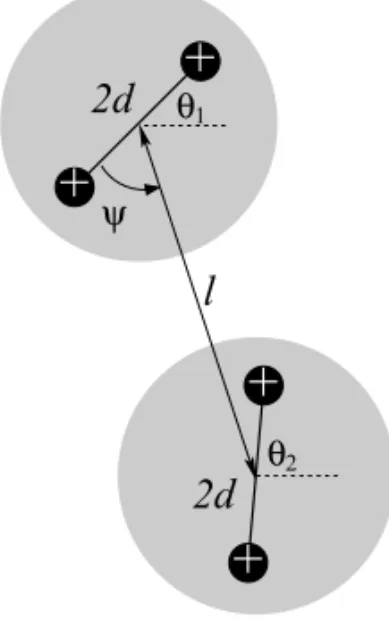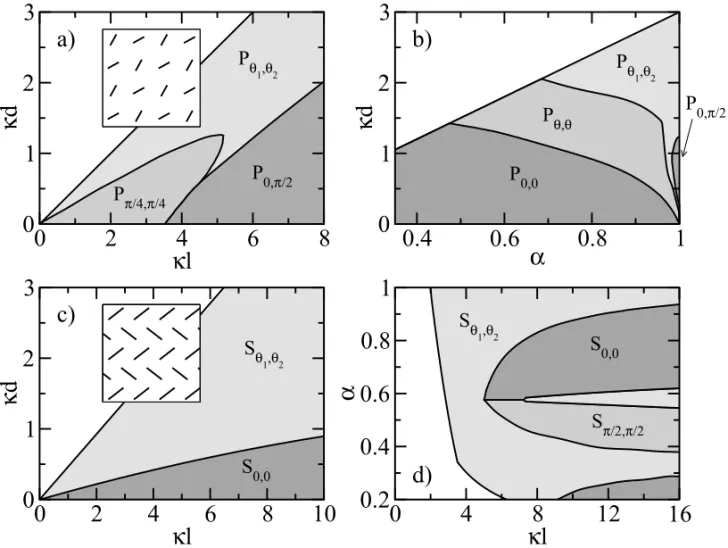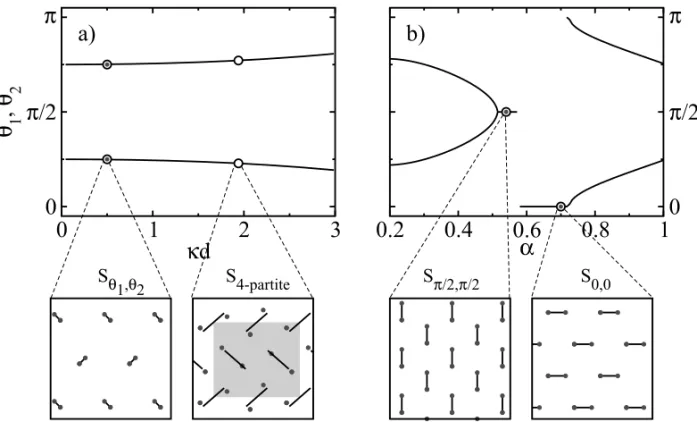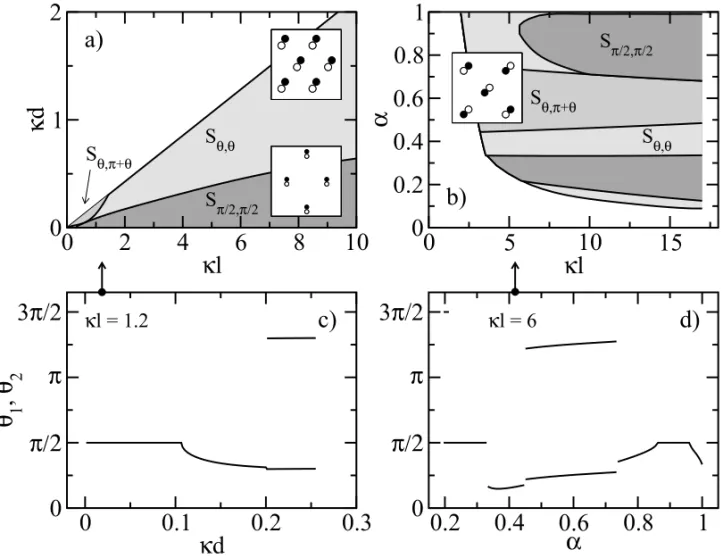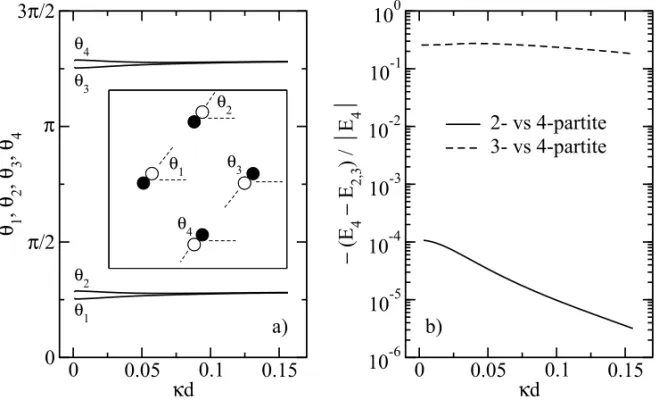(Annals of the Brazilian Academy of Sciences) ISSN 0001-3765
www.scielo.br/aabc
Dimeric and dipolar ground state orders in colloidal molecular crystals
EMMANUEL TRIZAC1, SAMIR EL SHAWISH2 and JURE DOBNIKAR2
1Université Paris-Sud, Laboratoire de Physique Théorique et Modèles Statistiques (CNRS UMR 8626), 91405 Orsay Cedex (France) 2Department of Theoretical Physics, Jožef Stefan Institute, Jamova 39, 1000 Ljubljana, Slovenia
Manuscript received on May 2, 2008; accepted for publication on April 1, 2009
ABSTRACT
A two dimensional colloidal suspension subject to a periodic substrate evolves into a colloidal molecular crystal under situations of strong confinement. We focus on the long range orientational order thereby emerging, in the ground state. We study by simulations the situations where in each trap lies a pair of identical colloids, or alternatively a pair of oppositely charged macroions. We consider square or triangular geometries for the periodic confinement, together with less symmetric distorted lattices.
Key words: colloidal molecular crystals, confined colloidal suspensions, orientational ordering, screened Coulomb interactions, simulated annealing.
INTRODUCTION AND BACKGROUND
Whereas Coulombic interactions are recognized as es-sential to the understanding of the phase and structural properties of colloidal suspensions in the broad sense, there has been comparatively little work devoted to the behaviour of charged composite objects in a solution. The spherical shape is, however, more the exception than the rule in the colloidal realm, and to illustrate the non-intuitive features of the coupling between anisotropy of a macroion charge distribution (a colloid), and screening by an atmosphere of microions, we consider the simple dumbbell problem of two identical spherical colloids of chargeqin an electrolyte of Debye lengthκ−1(the
sol-vent is hereafter considered as a structure-less medium of constant dielectric permittivity). One may naively think that, at a large distance from the above dimer, one recovers an isotropic (screened) electrostatic potential
φ, as is the case in vacuum where only the
monopo-Selected paper presented at the IUTAM Symposium on Swelling and Shrinking of Porous Materials: From Colloid Science to Poro-mechanics – August 06-10 2007, LNCC/MCT.
Correspondence to: Emmanuel Trizac E-mail: trizac@lptms.u-psud.fr
lar contribution matters. To appreciate why such an ex-pectation is incorrect, we resort to Debye-Hückel theory (see e.g. Levin 2002, Levin et al. 2003) whereφobeys ∇2φ=κ2φ. Denoting 2d the distance between the two colloids andψ the angle between the colloids’ center-to-center line and the vector (with modulus r) joining the dimer middle to an arbitrary point where the po-tential φ is computed (see Fig. 1), we can write φ as the superposition of two screened Coulomb potentials, which admits the largerform
φ (r, ψ )∼qe −κr
r cosh(κdcosψ). (1) Remarkably, the angular and radial dependencies factor-ize, so that the anisotropy of the source of the potential is relevant at all scales, at variance with vacuum or plain dielectric phenomenology. Another interesting charac-teristics emerges when one considers a dipole (i.e. a doublet+q/−q, with again inter-center distance 2d, see Fig. 5): φ may again be written as the sum of two screened Coulomb contributions, which now differ by the sign of their prefactors, so that again for large distances:
φ (r, ψ )∼qe −κr
This expression is of the same order inras Eq. (1), and more generally, all multipoles contribute to the leading term in the large distance decay of the electric potential for an arbitrary charge distribution (Trizac et al. 2002, Agra et al. 2004a, Ramirez and Kjellander 2006).
Surprisingly, these considerations are essential to understand the phase behaviour of the recently obtained colloidal molecular crystals, where a light lattice of traps produced by interfering laser beams induces the crystallization of an otherwise two dimensional suspen-sion of spherical colloids. Such systems exhibit a com-plex phase diagram that has been studied experimen-tally (Brunner and Bechinger 2002), numerically and theoretically (Reichhardt and Olson 2002, Agra et al. 2004b, Reichhardt and Olson-Reichhardt 2005, Sarlah et al. 2005, 2007, El Shawish et al. 2008). For illus-trative purposes, we consider the case of a rectangu-lar lattice of confining traps in a strong pinning regime where there are exactly two colloids pertrap, thereby forming a dimer. Restricting for simplicity the analysis to nearest neighbor interactions, and assuming that the large distance form (1) holds, we see that the potential created by a single dimer is minimum in theψ =π/2 direction, so that a pair of interacting dimers minimizes its repulsion in the parallel configuration, when both are perpendicular to the line joining their centers (shown with the double arrow of length l in Fig. 1). Such a pair configuration does not allow to construct a trivial ground state on the square lattice, and leads to a frus-trated situation. We have, therefore, resorted to numer-ical simulations to analyse the corresponding order that arises. On the other hand, the situation appears simpler when dipoles are considered on the square lattice: from Eq. (2) a given pair of dipoles maximizes its attraction when both are aligned to their center-to-center separa-tion. A plausible ground state then naturally emerges, with stripes of aligned dipoles with alternating orien-tation (up and down) from stripe to stripe. In such a configuration, not all pairs of dipoles are in the optimal configuration though, due to the lattice geometry. In this case, and to analyse other lattice geometries, numeri-cal simulations are necessary to clarify the orientational ordering that is selected by the interactions considered. It is essential here to realise and keep in mind that the energy of a given configuration is not invariant upon
si-multaneously rotating all dimers or dipoles orientations, at variance with Heisenberg spins.
θ1
θ2 ψ
2d
l
+
+
+
+
2d
Fig. 1 – Schematic view of charged dimers in two different traps (shaded circles). lis the distance between the neighboring traps, 2d is the size of the “colloidal molecule” andθ1,2are the characteristic angles. The large distance potential created by the upper dimer in the direction of the second one is given by Eq. (1), where the angleψis shown on the figure.
0
4
8
12
16
κ
l
0.2
0.4
0.6
0.8
1
α
0.4
0.6
0.8
1
α
0
1
2
3
κ
d
0
2
4
6
8
10
κ
l
0
1
2
3
κ
d
0
2
4
6
8
κ
l
0
1
2
3
κ
d
S
θ1,θ2
S
0,0S
π/2,π/2S
θ1,θ2
S
0,0a)
b)
c)
d)
P
θ1,θ2
P
0,π/2P
π/4,π/4P
θ1,θ2
P
θ,θP
0,0P
0,π/2
Fig. 2 – Summary of phase diagrams for rigid dimers on a rectangular lattice (upper row) for a)α = 1 and b)κl = 6, and on a triangular lattice (lower row) for c)α=0.9 and d)κd =1. Colours denote the different phases with particular values of the bipartite anglesθ1andθ2. Note that the void (white) regions correspond to unphysical parameter ranges such asd ≤αl/2 (a given trap cannot extend further than half the inter trap distance).
REPULSIVE IN-TRAP INTERACTIONS
Here we consider the dimeric case with two colloids of the same charge per trap. We distinguish between a simplified model of trapping where a fixed dimer size is assumed (rigid dimer model), and the “full” problem where the dimer is allowed to adjust its size to the con-fining potential imposed. This leads in some cases to a spontaneous symmetry breaking where all dimers do not have exactly the same size in neighboring wells.
In the rigid approach, the intra-trap colloidal dis-tance is fixed to a value 2d(see Fig. 1) and we consider that the rigid dimers only have a rotational degree of freedom (θi in Fig. 1). The ground state is then
deter-mined by minimizing the screened Coulombic energy:
Ec=K
X
i6=j
exp(−κri j)
κri j
, (3)
whereKis here immaterial since the focus in on ground state properties,κmeasures the range of the screened in-teraction, andri j denotes the distance between colloids i and j (the sum above runs over all possible pairs of colloids). The trapping potential is not accounted for, but implicitly taken into account through the d value: stronger confinement leads to a decrease of this distance. Within such an approach, the relevant dimensionless pa-rameters areκd and κl (see Fig. 1). In addition, we introduced the aspect ratioα(rescaling all distances in one principal direction of the lattice by a factorα). For instance, if α = 1 corresponds to a square geometry,
α6=1 is then for a rectangular unit cell.
0
0.5
1
1.5
2
2.5
κ
d
0
π
/4
π
/2
θ
1,
θ
20
0.5
1
1.5
2
2.5
κ
d
0
π
/4
π
/2
P
0,π/2P
θ1,θ2
P
0,0P
θ,θa)
b)
Fig. 3 – Comparison between the ground states for dimers on a square substrate, obtained considering the full “flexible” model including explicitly the trapping potential (results shown with circles), against the restricted approach where the dimers are considered as rigid objects (results shown by the continuous curves). (a)κl=4.5,
α=1 and (b)κl=6,α=0.9. The insets display the typical configurations in both rigid and flexible models.
the square lattice (see the inset in the upper row), and in the form of parallel stripes on the triangular lattice. We name these orders Pθ1,θ2 and Sθ1,θ2 respectively. In particular, the P0,π/2phase corresponds to an order
reminiscent of an antiferromagnetic phase (with alter-nating “vertical” and “horizontal” dimers on neighbor-ing traps). It should be emphasized that a phase indexed by an unspecified angleθ or a pair of anglesθ1, θ2
ex-hibits an order that can be tuned upon changing the pa-rameters (α, κd, κl). An example showing how charac-teristic angles change is provided in Figure 3. On the other hand, there exists other phases where the angles are constant throughout the whole domain of existence, see e.g. phases Pπ/4,π/4 in Figure 2-a) or S0,0 and Sπ/2,π/2in Figure 2-d). We note that, on the equilateral
triangular lattice, phases S0,0 and Sπ/2,π/2 coincide,
but this is no longer the case in the distorted situation whereα6=1.
Althougha priorinatural, the rigid dimer assump-tion significantly restricts the phase space of the system and may prevent the formation of more exotic phases
ab-0
1
2
3
κ
d
0
π
/2
π
θ
1,
θ
20.2
0.4
0.6
0.8
1
α
0
π
/2
π
S
4-partiteS
θ1,θ2
S
π/2,π/2S
0,0a)
b)
Fig. 4 – Same as Figure 3 but on a triangular lattice with (a)κl =6,α =1 and (b)κl= 6,κd =1. In the equilateral configuration (α=1), tetrapartite ground state configurations appear for flexible dimers with large
κd(shaded region in a)). A typical tetrapartite configuration (disks) with enlarged unit cell is shown in the inset along with the “rigid” bipartite configuration (lines) for comparison.
ruptly to anS0,0and is finally back to the Sθ1,θ2, with, however, more separated characteristic angles (larger value of|θ1−θ2|), than in the lowαregime.
ATTRACTIVE IN-TRAP INTERACTIONS
Our interest now goes to the dipolar case, with two oppositely charged colloids per trap (see Fig. 5). As alluded to earlier, it becomes irrelevant to distinguish between the rigid and flexible cases: due to the strong colloidal attraction, the dipole behaves as a rigid object. As might have been anticipated, the ground state on the rectangular lattice is ofP−π/2,π/2fashion, see Figure 6.
The numerical results have again been obtained with simulated annealing. However, when the relevant struc-tures have been identified, with the correct sublattices, the problem at hand depends on a small number of para-meters, and lends itself to a straightforward direct en-ergy minimization. We have compared both approaches (annealing and direct minimization), that give very sim-ilar results.
On the other hand, the phase diagram for triangu-lar lattices is more diverse, with additional
antiferro-θ1
θ2
2d
l
−
+
−
+
Fig. 5 – Schematic representation of two electric dipoles, i.e. dimers composed of positively and negatively charged colloids, in the traps (shaded circles). Here 2dis the size of a colloid whereas the other parameters have the same meaning as in Figure 1.
0
5
10
15
20
κ
l
0
0.2
0.4
0.6
0.8
1
α
0
2
4
6
8
10
κ
l
0
1
2
κ
d
P
-π/2,π/2a)
b)
P
-π/2,π/2Fig. 6 – Ground state phase diagram of oppositely charged dimers on a rectangular lattice for (a)α = 1
and (b)κd=1. TheP−π/2,π/2phase sketched in the insets is the ground state for all values ofα,κlandκd.
0
5
10
15
κ
l
0
0.2
0.4
0.6
0.8
1
α
0.2
0.4
0.6
0.8
1
α
0
π/2
π
3
π
/2
0
2
4
6
8
10
κ
l
0
1
2
κ
d
0
0.1
0.2
0.3
κ
d
0
π/2
π
3
π
/2
θ
1,
θ
2S
π/2,π/2S
θ,θS
θ,π+θκ
l = 6
S
θ,θS
π/2,π/2κ
l = 1.2
a)
b)
c)
d)
S
θ,π+θFig. 7 – Phase diagram for opposite charged dimers on a triangular lattice for (a)α = 0.8 and (b)κd = 0.5.
The insets show the representative stripe configurations. The parameter dependence of bipartite angles along the
0
0.05
0.1
0.15
κ
d
0
π
/2
π
3
π
/2
θ
1,
θ
2,
θ
3,
θ
40
0.05
0.1
0.15
κ
d
10
-610
-510
-410
-310
-210
-110
0−
(E
4
−
E
2,3) /
E
4
2- vs 4-partite
3- vs 4-partite
a)
b)
θ1 θ2 θ3 θ4
θ1 θ2
θ3
θ4
Fig. 8 – Emergence of tetrapartite ground state configurations for opposite charged dimers on a triangular
lattice withα=0.7 andκl=0.8: (a) the parameter dependence of tetrapartite angles and (b) a comparison
of ground state energiesEi calculated for bipartite (E2), tripartite (E3) and tetrapartite (E4) lattices. In the
inset of (a) we show the tetrapartite unit cell configuration forκd=0.05.
the inset, is reminiscent of the ground state P−π/2,π/2
found on the square lattice, which is itself a stripe phase. The reason for this similarity is clear: with the particular
scaling factorα =1/√3 ≃0.57, the triangular lattice
is mapped onto a square one (with principal axis rotated
by an angle ofπ/4 with respect to the horizontal
direc-tion corresponding to a principal axis of the unscaled original triangular lattice). Forα ≃ 0.57 we therefore expect aSπ/4,5π/4phase on the triangular lattice. This is
precisely what is observed in Figure 7-d) where one can see that the couple(θ1, θ2)hits the value(π/4,5π/4)at
α = 1/√3 (see also the inset of Fig. 7-b) for a visual confirmation). Finally, in the low screening regime and forα < 1, we have observed a tendency towards tetra-partite ordering, as shown in Figure 8. This tendency is, however, weak: the resulting angles only slightly differ from those in the bipartite structure (it can be seen in graph 8-a) that|θ2−θ1| ≪ θ1) and, furthermore, the
energy differences involved are faint (Fig. 8-b)).
CONCLUSION
We have found by numerical simulations the orienta-tional orders associated to the ground state of the
While the dimeric case has been realised e xperi-mentally, we are not aware of any experimental studies with oppositely charged colloids. A first difficulty to overcome lies in the fact that, starting from a weakly modulated situation and gradually increasing confine-ment amplitude, the system may not organize sponta-neously with exactly one dipole per trap. On the other hand, with dimers, the strong colloid-colloid repulsion ensures that there are no defects in the corresponding crystal, i.e. exactly one dimerpertrap.
Finally, we emphasize that the Coulombic energy considered here [Eq. (3)] considers all pairs of dimers/ dipoles in the system, and does not assume that only in-teractions between nearest neighbor traps are relevant. The nearest neighbor assumption might seem natural at first glance, given the exponential dependence with respect to distance of the screened Coulomb potential. It may, however, prove incorrect, as has been uncovered in (El Shawish et al. 2008).
ACKNOWLEDGMENTS
We would like to thank Frédéric van Wijland and A. Sar-lah for useful discussions. The work was supported by the Slovenian Research Agency through grants P1-0055 and Z1-9303. We acknowledge the support of the bilat-eral program Proteus supported by the Slovenian Re-search Agency and the french Ministère des Affaires Etrangères et Européennes.
RESUMO
Uma suspensão bidimensional coloidal sujeita a um substrato periódico evolui para um cristal coloidal molecular em situa-ções de forte confinamento. Nós focamos na ordem de orien-tação emergindo a partir do estado fundamental. Fazendo uso de simulações, estudamos as situações onde em cada armadilha reside um par de colóides idênticos ou, alternativamente, um par de macro-íons de cargas opostas. Consideramos geome-trias quadradas ou triangulares para o confinamento periódico com arranjos simétricos com menor distorção.
Palavras-chave: cristais moleculares coloidais, suspensões coloidais confinadas, ordenamento de orientação, interações de Coulomb, recozimento simulado.
REFERENCES
AGRAR, TRIZAC E ANDBOCQUETL. 2004a. The inter-play between screening properties and colloid anisotropy: towards a reliable pair potential for disc-like charged par-ticles. Eur Phys J E 15: 345–357.
AGRAR,VANWIJLANDFANDTRIZACE. 2004b. Theory of Orientational Ordering in Colloidal Molecular Crystals. Phys Rev Lett 93: 018304.
BRUNNERM ANDBECHINGERC. 2002. Phase Behavior of Colloidal Molecular Crystals on Triangular Light Lat-tices. Phys Rev Lett 88: 248302.
ELSHAWISHS, DOBNIKARJANDTRIZACE. 2008. Ground states of colloidal molecular crystals on periodic sub-strates. Soft Matter 4: 1491.
LEVINY. 2002. Electrostatic correlations: from Plasma to Biology. Rept Prog Phys 65: 1577–1632.
LEVINY, TRIZACEANDBOCQUETL. 2003, On the fluid-fluid phase separation in charge stabilized colloidal sus-pensions. J Phys Condens Matt 15: S3523–S3536. RAMIREZR ANDKJELLANDER R. 2006. Effective
multi-poles and Yukawa electrostatics in dressed molecule the-ory. J Chem Phys 125: 114110.
REICHHARDT C.ANDOLSONCJ. 2002. Novel Colloidal Crystalline States on Two-Dimensional Periodic Subs-trates. Phys Rev Lett 88: 248301.
REICHHARDTCANDOLSON-REICHHARDTCJ. 2005. Or-dering and melting in colloidal molecular crystal mix-tures. Phys Rev E 71: 062403.
SARLAHA, FRANOSCH TANDFREYE. 2005. Melting of Colloidal Molecular Crystals on Triangular Lattices. Phys Rev Lett 95: 088302.
SARLAHA, FREYEANDFRANOSCHT. 2007. Spin models for orientational ordering of colloidal molecular crystals. Phys Rev E 75: 021402.
TRIZACE, BOCQUETL, AGRAR, WEISJJANDAUBOUY
